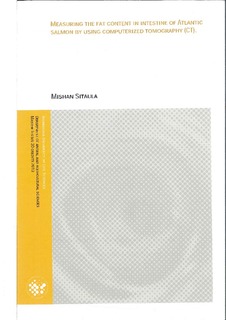| dc.description.abstract | The aim of our study was to use the CT scanning as a non-destructive method to find out the amount of fat in the Atlantic salmon intestinal area. Farmed Atlantic salmon (Salmo salar) was subjected to computerized X-ray tomography (CT) to evaluate CT as a non-destructive and rapid method for analyzing intestinal fat percentage. The salmon that was used in this study were in size, weight and slaughter percentage representative for the commercial salmon in Norway today. The study consisted of a total of 95 Atlantic salmons with weight varying from 2,125 g to 7,369 g and lengths varying from 82 cm to 58 cm. Out of 95 fishes 25 of them were selected for scraping the intestinal fat manually. The correlation between the length and weight of the fishes is significant (R2=0.79).
The fish were scanned at four anatomical positions (behind pectoral fin (scan 1), in front (scan 2) and behind the dorsal fin (scan 3) and, in front of anal fin (scan 4) through vent). The intestinal fat content correlated positively with CT values over all scan positions, demonstrating that CT can be used as a non-destructive method to predict the intestinal fat percentage in salmon (p<0.001). The highest fat content seemed to be present at the position in front of dorsal fin (scan 2) and the lowest fat content in front of anal fin (san 4). The position in front of the dorsal fin i.e. scan 2 (R2=0.68) and the average scan (R2=0.71) gave highest correlations value. The pixel values and the viscerosomatic index (VSI) for all scans were significantly correlated and, scan 2 gave a highest correlation value (R2=0.65) providing the most information about the total fat content in the intestine and the slaughter yields. The scrap intestinal fat for 25 fishes and their VSI values were also significantly correlated meaning that CT scanner can be used in the production line in order to estimate the yield of fish carcass.
Our study show that the amount of intestinal fat can to a significant degree can be estimated by CT-scanning which has not been shown before. This method seems to be promising and suggesting that it can be used in breeding for salmon with less storage of fat in the viscera and consequently better slaughter percentages. | no_NO |
